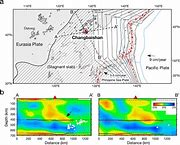Deep beneath the Earth’s surface in northeast China lies a fascinating geological phenomenon that has puzzled scientists for years. At the heart of this mystery is the relationship between deep-focus seismicity and the volcanic activity at Changbaishan, a prominent volcano in the region.
Cenozoic volcanoes dot the landscape of northeast China, with Changbaishan standing out as the largest among them. This volcanic field, known as CVF, is unique in its formation and continues to intrigue researchers seeking to unravel its secrets.
“Understanding the connection between deep earthquakes and volcanic activity at Changbaishan is crucial for deciphering the complex geological processes at play in this region,”
explains Professor Zhang Haijiang from the University of Science and Technology of China, who led the research team.
To shed light on this enigma, Prof. Zhang’s team collaborated with Dr. Robert Myhill from the University of Bristol and employed advanced teleseismic double-difference tomography technology. By analyzing seismic data from global stations, they constructed a detailed 3D velocity model extending over 1,000 kilometers into the Earth’s depths.
The findings revealed a captivating discovery: beneath Changbaishan, a subducting slab was observed penetrating into the lower mantle while remaining stagnant on its northern and southern flanks within the mantle transition zone. This unique configuration provided an avenue for hot materials to well up beneath the slab, acting as a deep-seated heat source fueling volcanic activity at CVF.
Moreover, an intriguing correlation emerged between deep earthquake clusters and the curved path of the Pacific plate’s subduction through crucial interfaces within Earth’s interior. The localized deformations caused by this process were identified as key triggers for deep earthquakes in the area.
“This study offers a novel perspective on how deep-source earthquakes are generated and establishes a clear link between CVF volcanism and deep-seated seismic activities,”
notes Dr. Robert Myhill.
By unifying these seemingly disparate phenomena under one explanatory framework rooted in dynamic geological processes associated with partial subductions of tectonic plates, researchers have unlocked new insights into earth science dynamics.
In conclusion, exploring how deep-focus seismicity influences Changbaishan volcanism not only enriches our understanding of geophysical processes but also highlights nature’s intricate interplay between tectonic forces shaping our planet’s surface features.









Leave feedback about this